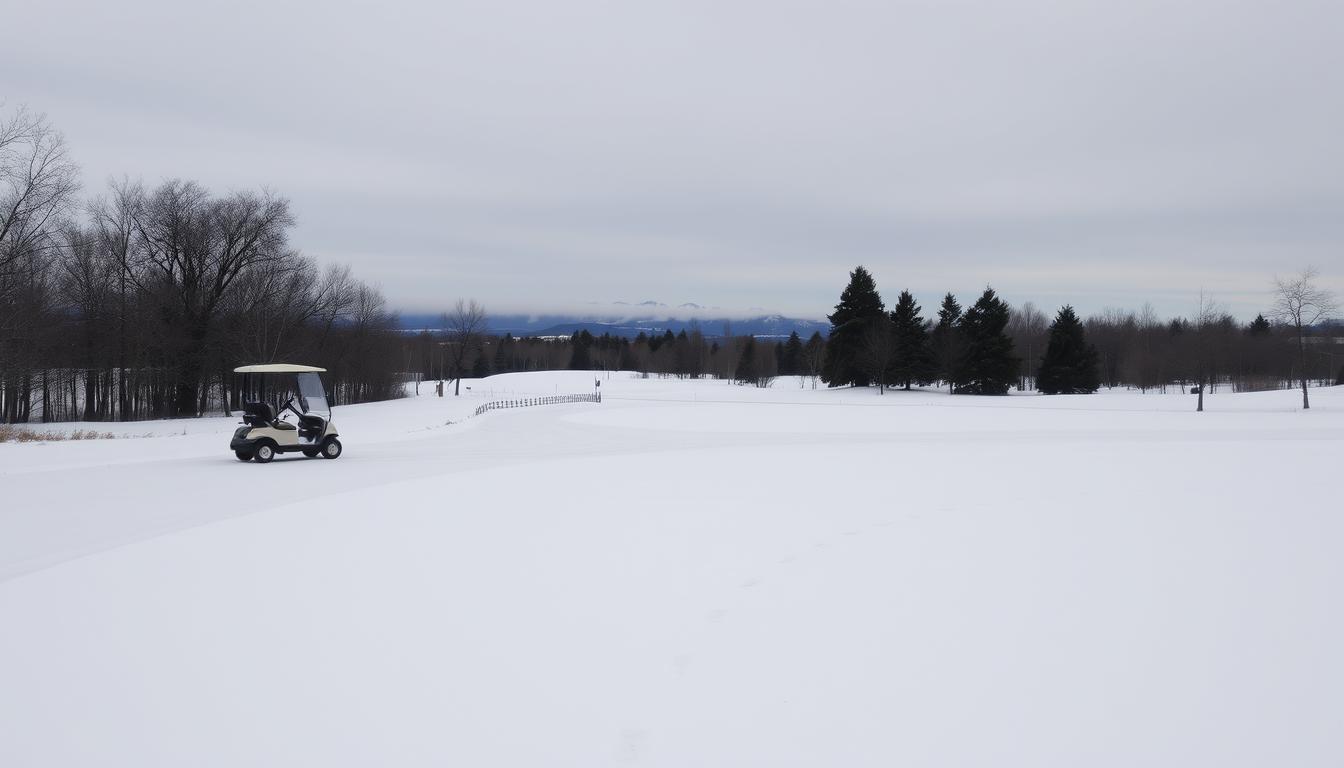Did you know that 78% of golf courses in Colorado remain open year-round? This fact defies the notion that winter golf is rare. Courses like Inverness Golf Course in Englewood, Colorado open 365 days a year, and the stunning Redlands Mesa in Grand Junction, show that winter golf in Colorado is quite accessible.
Winter golf presents a distinct experience, with fewer players and possible discounts on green fees. Yet, it’s crucial to grasp the seasonal availability of golf courses. While public courses often stay open all year, private clubs might shut down during the cold months. Mild climates enable continuous play, but harsh winters can cause temporary closures.
Booking information and tee times differ significantly in winter. Arrowhead Golf Club in Littleton may close seasonally, so verifying their website for current info is wise. Fox Hollow in Lakewood, with its three unique nines, remains open all year, offering varied options for winter golfers.
When planning your winter golf outing, remember that frost delays and snow cover can affect course conditions. Courses like Saddle Rock in Aurora are open all year but depend on the weather. Others, such as Patty Jewett in Colorado Springs, allow play with occasional snow interruptions.
Key Takeaways
- Many Colorado golf courses remain open during winter
- Winter golf offers unique experiences and potential discounts
- Seasonal availability varies between public and private courses
- Weather conditions can impact tee times and course accessibility
- Check individual course websites for current booking information
- Some courses offer year-round play with occasional weather-related closures
Table of Contents
- 1 Factors Influencing Golf Course Operations in Winter
- 2 Regions Where Golf Courses Are Open in the Winter
- 3 Benefits of Playing Golf in the Winter
- 4 Challenges of Winter Golfing
- 5 Preparing for Winter Golf
- 6 How to Find Open Golf Courses in the Winter
- 7 Popular Winter Golf Events and Tournaments
- 8 Winter Golf Tips and Strategies
- 9 Sustainability and Environmental Considerations
- 10 Future of Winter Golfing
Factors Influencing Golf Course Operations in Winter
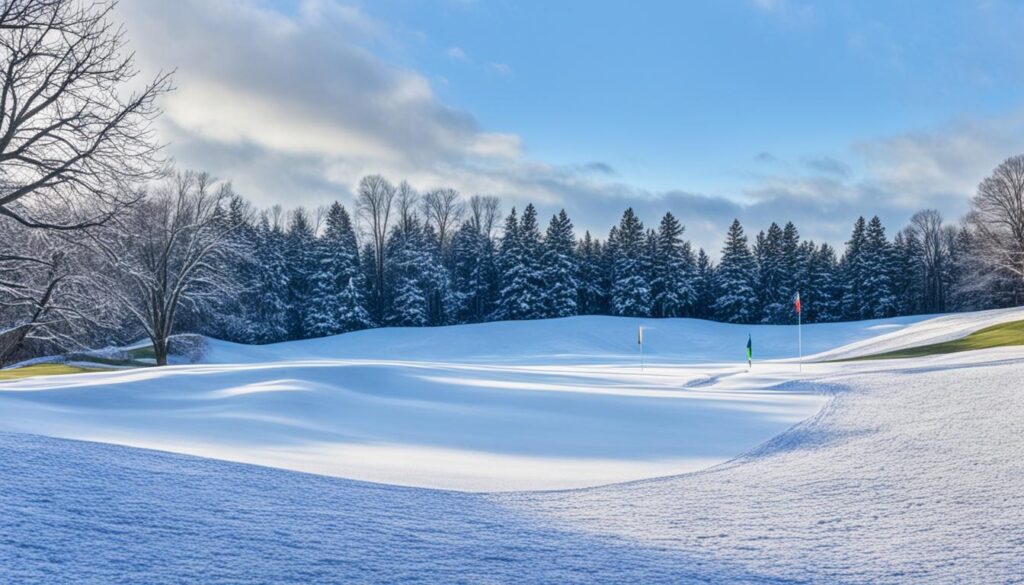
Golf course operations in winter face unique challenges due to winter weather conditions. It’s essential for both players and course managers to grasp these factors. Let’s look at the important elements that define winter golfing experiences.
Winter Golfing Overview
Winter golfing presents a unique experience. Cold temperatures significantly impact golf ball distance, leading to a 10-13 yard reduction in carry distance. Also the cold can stiffen muscles, decreasing club head speed by up to five miles per hour.
Seasonal Availability
The availability of golf courses in winter varies widely. Climate and location are crucial in determining whether a course remains open. Courses in milder regions may stay open all year, whereas those in colder climates might close due to snow or frost.
Course Maintenance Challenges
Winter maintenance for golf courses becomes more intricate. Courses often use winter covers to minimize injury risk and enhance spring conditions. This period is ideal for equipment repair, tree removal, and updates to irrigation systems. Ensuring proper winterization of golf carts is also crucial.
Winter Golfing Demand
Seasonal demand for winter golfing fluctuates. Some players relish the unique conditions, while others prefer warmer climates. To draw players, many courses offer special winter rates and packages.
| Winter Golf Considerations | Impact |
|---|---|
| Ball Flight | Shorter distances due to dense air |
| Club Performance | Stiffened shafts affect accuracy |
| Player Comfort | Reduced joint mobility and grip control |
| Course Condition | Requires special maintenance measures |
Understanding these factors aids golfers in preparing for winter play. It also helps course managers in maintaining their facilities effectively during the off-season.
Regions Where Golf Courses Are Open in the Winter
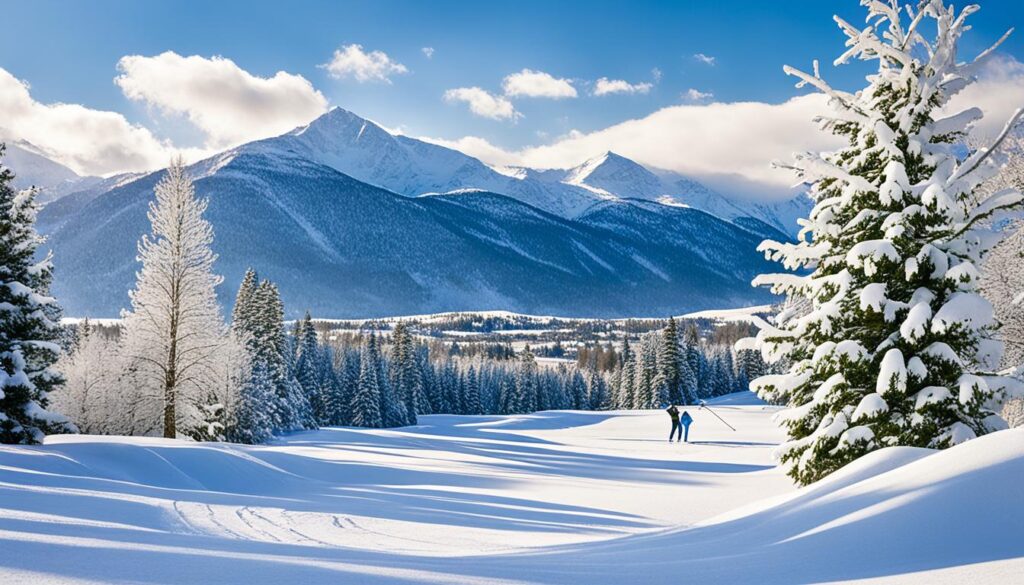
Winter doesn’t mean you must put away your golf clubs. Many destinations around the world offer golfing all year. Let’s look at into some prime spots for golfing even when snow blankets other areas.
Southern United States
Florida, Arizona, and California stand out for winter golf in the U.S. These states enjoy mild climates ideal for golfing all year. Florida, especially, is a haven for golfers with its array of top-tier courses.
| Course | Location | Green Fees | Tee Times |
|---|---|---|---|
| TPC Sawgrass | Ponte Vedra Beach, FL | $600-$720 | 7:00 AM – 2:00 PM |
| Pebble Beach Golf Links | Pebble Beach, CA | $575 | 6:30 AM – 3:00 PM |
| Cascata | Boulder City, NV | $395-$425 | 8:00 AM – 2:00 PM |
International Winter Golfing Havens
Looking beyond U.S. borders, Spain, Portugal, and Australia are top picks for winter golf. These locales offer perfect weather and breathtaking courses, perfect for a golfing escape.
Indoor Facilities and Golf Simulators
When outdoor golf isn’t an option, indoor facilities and golf simulators are a solid choice. These setups allow you to hone your swing and play virtual rounds on famous courses. Golf launch monitors in these places track your performance, enhancing practice sessions.
Whether you opt for sunny Florida or a cutting-edge simulator, winter golf spots ensure you can play your favorite sport all year. Always verify course availability and book tee times early for the best experience.
Benefits of Playing Golf in the Winter
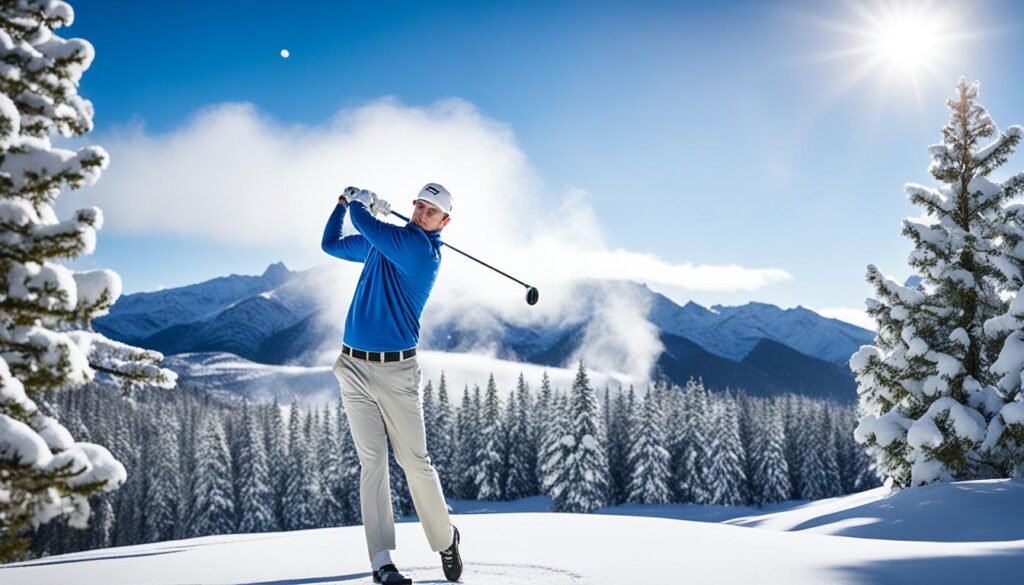
Winter golf presents unique advantages for enthusiasts. The colder months offer exciting opportunities to enhance your game and enjoy the sport in a different light. Let’s look at into the important winter golf benefits that make off-season play appealing.
Less Crowded Courses
One major perk of winter golfing is the reduced crowds. You’ll enjoy faster rounds and more relaxed play. With fewer golfers, you can take your time, practice your shots, and truly savor the experience without feeling rushed.
Unique Challenges and Experiences
Winter golf brings its own set of challenges that can improve your game. The colder temperatures and different course conditions require adapting your strategy and shot selection. This adaptation can lead to increased creativity and skill development, making you a more versatile player.
Potential for Discounted Rates
Many golf courses offer attractive off-season rates during winter. These discounts make it more affordable to play at prestigious courses that might be out of reach during peak season. Take advantage of these winter deals to experience top-notch facilities without breaking the bank.
| Golf Course | Winter Green Fee | Peak Season Fee | Savings |
|---|---|---|---|
| Pebble Beach Golf Links | $495 | $595 | $100 |
| TPC Sawgrass | $400 | $600 | $200 |
| Kapalua Plantation Course | $295 | $395 | $100 |
| Cascata | $275 | $375 | $100 |
Winter golfing not only provides cost-effective options but also allows you to focus on improvement. With less crowded courses, you can practice more freely and experiment with new techniques. The World Handicap System even lets you submit scores year-round, helping you track your progress and potentially lower your handicap during the off-season.
Challenges of Winter Golfing
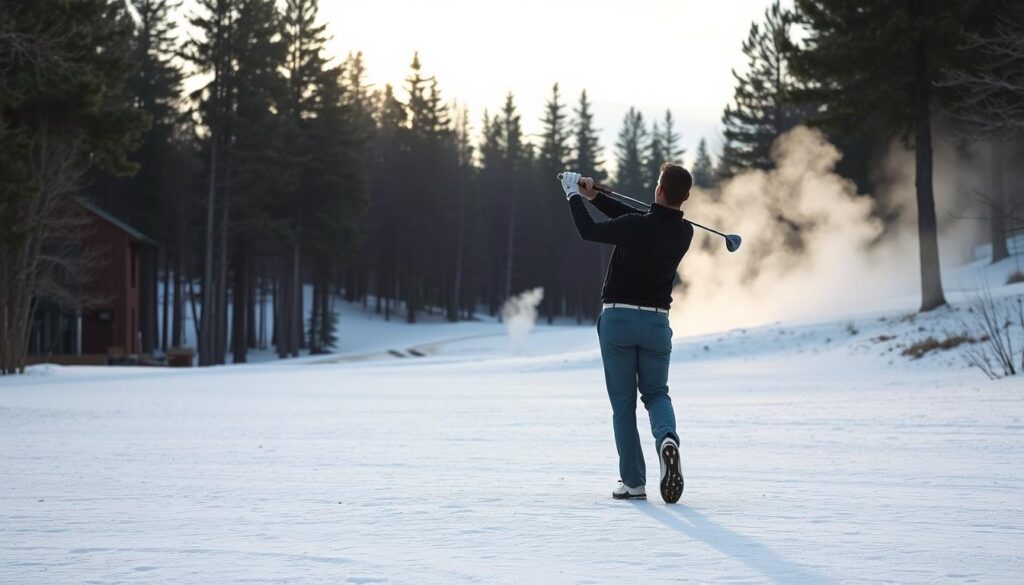
Winter golfing presents unique challenges that push even the most skilled players to their limits. The cold weather demands adjustments in both your approach and your equipment to keep up your performance.
Weather Conditions and Their Impact on Play
Cold weather significantly impacts your golf game. A 10-degree drop in temperature can reduce your distance by about 2 yards. The dense air increases resistance, leading to a 6-yard loss on average. Also your clubhead speed may drop by 5 mph, resulting in a 10-13 yard reduction with a driver.
Course Conditions and Maintenance Issues
Winter transforms golf courses. Frozen ground makes greens slower, making putting more difficult. Hazards become harder to navigate. Frost delays are frequent, disrupting tee times and schedules.
Limited Daylight Hours
Shorter days limit tee times. Many courses shorten their hours, closing early from November to March. This can make it challenging to complete a full round of golf.
| Weather Impact | Normal Conditions | Winter Conditions |
|---|---|---|
| Driver Distance | 258 yards | 224 yards |
| Clubhead Speed | 100 mph | 95 mph |
| Ball Flight | Normal | Lower and shorter |
To overcome these challenges, use brightly colored balls for better visibility, wear appropriate winter gear, and adjust your putting technique for slower greens. With proper preparation, you can still enjoy a fulfilling game of golf in the cold.
Preparing for Winter Golf

Winter golf presents a distinct challenge, demanding specific preparation. We’ll look at into the essentials for gearing up for cold weather and sustaining performance on the course.
Cold Weather Golf Gear
Layering is paramount in winter golf attire. Begin with a short-sleeve shirt, layer it with a turtleneck or sweater, and finish with a waterproof jacket. This combination ensures warmth without hindering your swing. Warm gloves are also crucial for maintaining a secure grip on your clubs.
Cold Weather Golf Tips
Opting for walking over a cart enhances warmth and supports the course. Cold weather impacts ball flight, so adjust your club selection accordingly. Many golfers find winter rounds at 9-hole courses more manageable and enjoyable.
Golf Safety in Winter
Winter golf safety is paramount. Be vigilant for icy patches and swiftly changing weather. Consider the reduced daylight hours. Despite the hurdles, winter golf remains a prime way to maintain fitness and enjoy the game.
| Winter Golf Considerations | Impact | Solution |
|---|---|---|
| Cold Temperatures | Reduced ball flight distance | Adjust club selection |
| Icy Conditions | Increased slip hazard | Wear golf shoes with good traction |
| Limited Daylight | Shorter playing time | Start rounds earlier in the day |
How to Find Open Golf Courses in the Winter

Winter doesn’t mean you have to pack away your clubs. Many golf courses stay open year-round, offering unique experiences for dedicated players. Finding these winter-friendly courses is easier than ever with modern technology and resources.
Online Resources and Golf Course Directories
A winter golf course finder is your best friend when searching for places to play during colder months. Websites and apps dedicated to golf course availability provide up-to-date information on open courses. These platforms often allow you to filter results based on location, amenities, and tee time bookings.
Contacting Local Golf Clubs and Courses
Direct communication with golf clubs remains a reliable method to check course availability. Many clubs have specific winter policies and may offer special rates. For example, some courses in colder regions might only open their driving ranges or limit play to certain days.
Utilizing Golf Apps and Social Media Groups
Golf apps have revolutionized how players find and book tee times. These apps often provide real-time updates on course conditions and availability. Social media groups dedicated to golf can also be valuable resources for finding open courses and connecting with other winter golfers.
When planning your winter golf getaway, consider how elevation affects golf ball distance. This knowledge can help you choose the right course and adjust your game accordingly.
| Region | Average Winter Temp (°F) | Notable Courses | Tee Time Booking |
|---|---|---|---|
| Scottsdale, AZ | 65-69 | TPC Scottsdale | Online/Phone |
| Naples, FL | 76-78 | Tiburón Golf Club | Online/Phone |
| San Diego, CA | 65 | Torrey Pines | Online |
| Hilton Head, SC | 60-65 | Harbour Town Golf Links | Online/Phone |
With these resources at your fingertips, you’ll have no trouble finding great golf courses open during winter. Remember to check course conditions and book your tee times in advance to ensure a smooth winter golfing experience.
Popular Winter Golf Events and Tournaments

Winter golf tournaments infuse the cold season with excitement, presenting unique challenges and experiences for both players and spectators. These events highlight the adaptability of golf courses that remain open during winter, drawing enthusiasts from diverse regions.
Notable Winter Golf Tournaments
Several prestigious winter golf events capture the attention of the golfing community. The AT&T Pebble Beach Pro-Am, held annually in California, stands out. This tournament pairs professional golfers with celebrities, creating a blend of fun and competition against the stunning Pacific coastline.
Participation and Spectating
For those keen on participating in winter golf tournaments, many courses offer spots for amateurs. Check local golf club websites or contact them directly for registration details. Alternatively, these events often welcome spectators, providing a unique opportunity to witness top players in action amidst the crisp winter air.
Community Impact
Winter golf events have a profound impact on local economies and community spirit. They draw visitors, boost hotel bookings, and support local businesses. Moreover, these tournaments inspire young golfers, promoting the sport’s growth even in colder months.
| Golf Course | Green Fees | Tee Times |
|---|---|---|
| Pebble Beach Golf Links | $575 | 7:00 AM – 3:00 PM |
| Streamsong Resort (Blue Course) | $275 | 7:30 AM – 2:30 PM |
| Kiawah Island Ocean Course | $383 | 8:00 AM – 2:00 PM |
Winter Golf Tips and Strategies

Winter golf presents unique challenges. Mastering winter golf techniques can help you enjoy the sport year-round. Next we will look at some cold weather golf strategies and golf equipment adjustments to improve your game.
Adjusting Your Game for Winter Conditions
Cold weather affects your golf game in several ways. Golf balls don’t fly as far, and consistency becomes challenging. Focus on improving square clubface contact for better shots. Consider using a lower-compression golf ball to improve distance. Learning to control ball flight, including knockdown shots and stingers, is crucial for winter play.
Equipment Modifications and Recommendations
Winter calls for specific golf equipment adjustments. Use softer feel two-piece distance golf balls if you have a lower swing speed. Invest in winter golf gloves for better grip and comfort. Don’t leave clubs in your car overnight as cold can damage grips and shafts. Understanding course slope ratings can help you choose appropriate clubs for winter conditions.
Mental Preparation and Focus
Mental readiness is critical for winter golf. Expect longer warm-up times and plan accordingly. Stay positive despite harsh conditions. Choose optimal tee times, like mid-morning slots, for more comfortable play. Remember, walking the course helps maintain body warmth and flexibility.
| Winter Golf Tips | Benefits |
|---|---|
| Use lower-compression balls | Improved distance in cold |
| Wear layered clothing | Better comfort and warmth |
| Use hand warmers | Maintain hand dexterity |
| Walk the course | Keeps body warm and flexible |
| Avoid alcohol | Maintains core body temperature |
Sustainability and Environmental Considerations
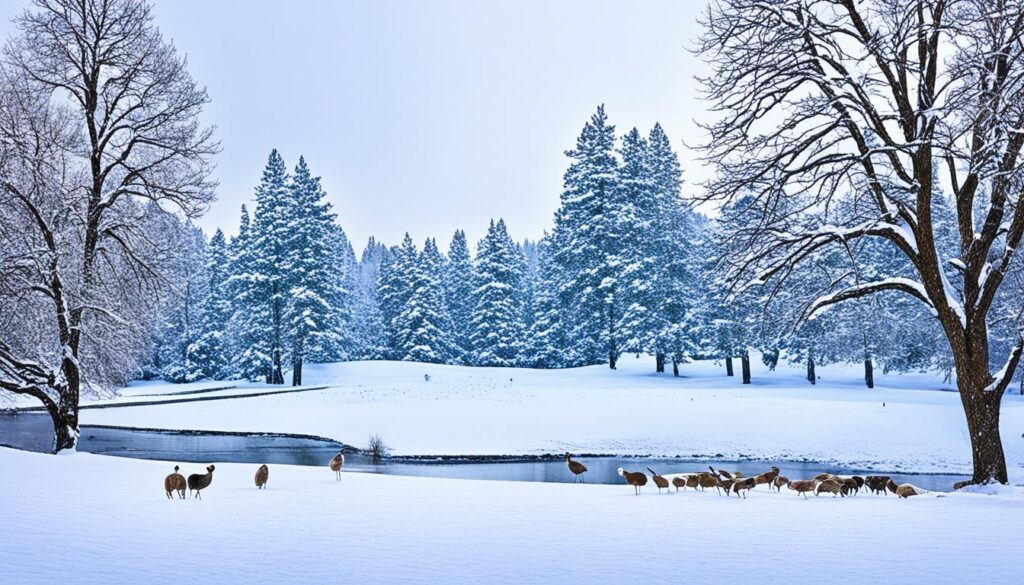
Golf courses face unique challenges in balancing playability with ecological responsibility. This is especially true for winter golfing, which impacts course ecology differently than summer play. Next we will look at how sustainable golf practices are shaping the future of this beloved sport.
Impact of Winter Golfing on Course Ecology
Winter play presents distinct challenges for golf course ecology. Cold temperatures and frost can damage turf, while snow cover may lead to fungal diseases. Golf courses must adapt their management strategies to protect the delicate balance of their ecosystems during these harsh months.
Eco-friendly Practices for Winter Course Maintenance
Many courses are adopting eco-friendly course maintenance techniques to minimize their environmental impact. These include:
- Using organic fertilizers and pesticides
- Implementing specialized irrigation systems
- Employing advanced turf management techniques
- Choosing drought-resistant grass varieties
These practices not only benefit the environment but also contribute to long-term cost savings for golf clubs.
Water Conservation and Wildlife Protection
Water management is crucial for sustainable golf, especially in semi-arid regions. Courses like Marty Sanchez Links de Santa Fe in New Mexico have implemented innovative water conservation strategies. These include:
- Efficient irrigation systems
- Weather tracking technology
- Soil moisture monitoring
Also golf courses are increasingly focusing on wildlife protection. They create habitats for local species and adjust maintenance schedules to minimize disturbance during critical periods.
| Sustainability Practice | Environmental Benefit | Economic Benefit |
|---|---|---|
| Organic fertilizers | Reduced chemical runoff | Lower long-term costs |
| Water conservation | Preserved water resources | Reduced utility expenses |
| Wildlife protection | Enhanced biodiversity | Improved course aesthetics |
By embracing these sustainable practices, golf courses can ensure their longevity while protecting the environment they depend on. The future of golf lies in this delicate balance between sport and nature.
Future of Winter Golfing
The future of winter golfing is promising, with new golf industry trends on the horizon. Despite fewer players than in summer, winter golf is growing in popularity among those who relish the challenge. Courses are evolving to cater to this trend, offering unique experiences that distinguish winter golf.
Trends in Winter Golf Course Operations
Golf courses are adopting innovative strategies to draw in winter players. Some are introducing night golf with cutting-edge lighting, enabling play even when daylight is scarce. Meanwhile, maintenance techniques are advancing. Superintendents are employing sophisticated methods like carbohydrate loading and fungicide application to safeguard turf against winter damage, ensuring optimal playing conditions all year.
Innovations in Winter Golfing Equipment and Apparel
Winter golf innovations are enhancing the cold-weather experience. The market is seeing the arrival of specialized gear, such as thermal gloves, heated golf balls, and all-weather shoes. These advancements are crucial for maintaining performance in cold conditions, potentially leading to better skills and year-round play.
Potential for Growth in Winter Golf Tourism
Winter golf tourism is set to expand as players from colder regions seek out milder climates for their golfing pursuits. Courses in warmer locales are capitalizing on this trend, offering enticing packages to attract winter golfers. This could result in a more even distribution of golf tourism throughout the year, benefiting both players and the industry.
